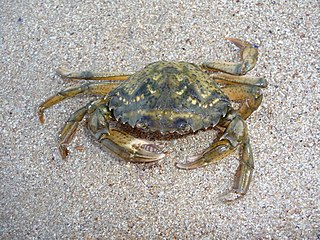
Carcinus aestuarii, also known as the Mediterranean green crab is a littoral crab, native to the Mediterranean Sea.
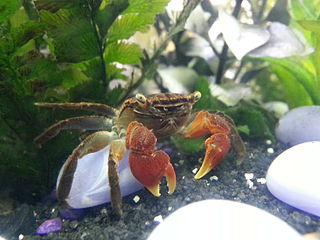
Perisesarma bidens, the red claw crab, is a species of crab found in the Indo-Pacific region from Zanzibar to Japan and Fiji.

Charybdis is a genus of swimming crabs in the family Portunidae. It is named after the monster Charybdis of Greek mythology.

Hemigrapsus oregonensis is a small shore crab of the family Varunidae; formerly classified under the family Grapsidae. It is known under several common names, including yellow shore crab, hairy shore crab, green shore crab, mud-flat crab, bay shore crab and Oregon shore crab. Despite its common name, the crab actually has a wide variety of coloration. It is found along the West Coast of the United States and Canada, specifically along shorelines and similar geographical areas. In 2009, H. oregonensis was included on a list of animals petitioning for the endangered species label, but there was not enough scientific information available for it to be considered as such, so it remains unevaluated to the present day.

Cynoglossus is a genus of fish in the family Cynoglossidae. Most species are indigenous to the Indo-Pacific region, but there are also a few in warmer parts of the East Atlantic. They are commonly found in shallow waters on a muddy or sandy bottom, including estuaries and a few species are restricted to fresh water. One species Cynoglossus sinusarabici has invaded the Mediterranean Sea through the Suez Canal from the Red Sea, a process known as Lessepsian or Erythrean migration.

Xantho hydrophilus, the furrowed crab or Montagu's crab, is a species of crab from the family Xanthidae. It is yellowish-brown and grows to a carapace width of 70 mm (2.8 in). It is a nocturnal omnivore that lives in shallow marine waters from western Scotland to the Cape Verde Islands.
Brachynotus sexdentatus is a species of crab in the family Varunidae. It is native to the Mediterranean Sea and Black Sea, and became established for a time in Swansea Docks. It grows to a maximum carapace width of 18 mm (0.71 in), and lives in shallow water on muddy bottoms.

Charybdis natator, the ridged swimming crab, wrinkled swimming crab or rock crab, is a widespread Indo-Pacific species of swimming crab from the genus Charybdis. It gets its name from the ridges on the dorsal surface of the carapace. It is a crab species which is of minor importance in fisheries.
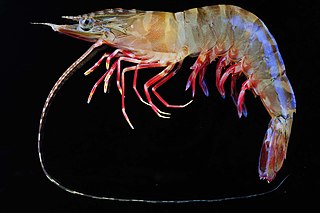
Penaeus semisulcatus, the green tiger prawn or grooved tiger prawn, is a commercially important species of prawn in the genus Penaeus.
Atergatis roseus, the pancake crab, is a species of reef crab from the family Xanthidae with a natural range extending from the Red Sea to Fiji. It has colonised the eastern Mediterranean by Lessepsian migration through the Suez Canal. The flesh of this crab, like many other species in the family Xanthidae, is toxic.

Saron marmoratus, commonly known as the marbled shrimp, is a species of cleaner shrimp in the family Hippolytidae. It is found in the Indo-Pacific region but in 2013 it was also found off the coast of Lebanon, probably having reached the Mediterranean by Lessepsian migration through the Suez Canal from the Red Sea. It is a popular species in aquaria due to its easy care.
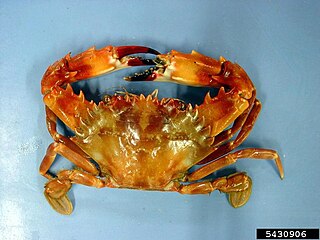
Charybdis hellerii, the Indo-Pacific swimming crab or spiny hands is a species of crab from the swimming crab family, the Portunidae. Its native range covers the Indian and Pacific Oceans but it has been introduced to the western Atlantic and has invaded the Mediterranean. It is a commercially exploited species in south-east Asia.

Eucrate is a genus of crabs of the family Euryplacidae containing the following species:

Actea savignii is a species of Indo-Pacific crab from the family Xanthidae which is one of the spiny-legged rock crabs. It has colonised the Levantine Sea by Lessepsian migration through the Suez Canal from the Red Sea since the mid 2000s.

Ashtoret lunaris, also known as the yellow moon crab, spotted moon crab or box crab, is an Indo-Pacific species of carnivorous crab which is a member of the family Matutidae. It has been recorded in the eastern Mediterranean since 2010, likely reaching it via the Suez Canal from the Red Sea by.

Hyastenus hilgendorfi is a species of spider crab from the family Epialtidae, classified in the sub-family Pisinae, from the Indo-Pacific region. It has been recorded in the Suez Canal and there have been a few records in the eastern Mediterranean, making it a Lessepsian migrant.
Notopus dorsipes is a species of frog crab from the family Raninidae which has an Indo-Pacific distribution and which has recently spread into the eastern Mediterranean. It is the only extant species in the genus Notopus.
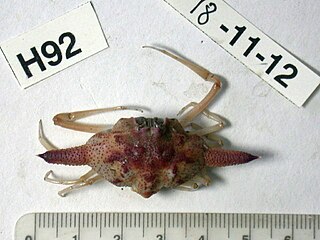
Ixa monodi, the Red Sea pebble crab is a species of pebble crab from the family Leucosiidae which prefers to burrow in sandy, shallow coastal waters. It was first described from the eastern Mediterranean where it is an invasive species having colonised the coasts of the Levantine Sea from the Red Sea by Lessepsian migration from the Red Sea via the Suez Canal.
Cynoglossus sinusarabici, the Red Sea tonguesole, is a species of tonguefish which occurs in the Red Sea and is now common in the eastern Mediterranean Sea following its migration through the Suez Canal. It was first recorded in the Mediterranean Sea off Israel in 1953 and successively observed in Turkey and Egypt. It has an elongated body with a rounded snout which has a rostral hook large, narrowly separated eyes. It has 99–101 dorsal fin rays, 78–79 rays in its anal fin and 8 rays in the caudal fin. The lateral line has 54–60 scales with 11 scales between the lateral line and the base of the dorsal fin. The lateral line is only present on the eyed side. It is uniform brown on the eyed side and whitish on the blind side. It grows to about 15 cm standard length.
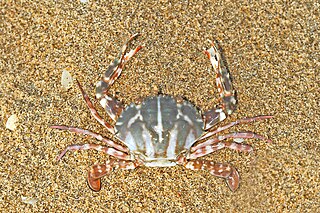
Charybdis feriata, the crucifix crab, is a species of swimming crab in the family Portunidae. It is found in the tropical and subtropical Indo-Pacific region.
















